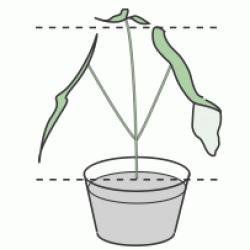Source Institutions
Source Institutions
Add to list Go to activity
Activity link broken? See if it's at the internet archive

In this food science activity, learners conduct an experiment that demonstrates the importance of light to plants. This 1-2 week activity allows learners to learn about the needs of plants and plant growth. This lesson guide includes background information, variation ideas, and bilingual (English/Spanish) handouts.
- 10 to 30 minutes
- 1 to 4 weeks
- $5 - $10 per group of students
- Ages 8 - 14
- Activity, Experiment/Lab Activity, Lesson/Lesson Plan
- English, Spanish
Quick Guide
Materials List (per group of students)
- 12 soaked bean seeds
- 4 dry bean seeds
- 4 hand lenses (magnifiers)
- 4 peat pots (3-in. size), or disposable cups
- 4 pieces of string or yarn (each approx. 6-in. in length)
- 2 cups of moistened soil
- Dispensing bottle (2-oz. size) or dropper
- Metric ruler
- Copies of student sheets
Subjects
-
Life Sciences
- Cells
-
Diversity of Life
- Plants
-
Ecology
- Energy Flow and Chemical Cycles
-
Human Body
- Health and Nutrition
-
Physical Sciences
- Energy
-
Chemistry
- Chemical Reactions
-
Vibration and Waves
- Light and Optics
-
Light and Optics
- Sunlight and Color
-
Mathematics
-
Data Analysis and Probability
- Data Analysis
- Data Collection
- Data Representation
-
Measurement
- Rate
- Number and Operations
- Reasoning and Proof
- Representation
-
Data Analysis and Probability
-
The Nature of Technology
-
The Design Process
- Problem Solving
-
The Design Process
-
The Nature of Science
-
The Scientific Process
- Conducting Investigations
- Gathering Data
- Formulating Explanations
- Communicating Results
-
The Scientific Process
Informal Categories
- Food and Cooking
- Gardening
- Nature and Environment
Audience
To use this activity, learners need to:
- see
- read
- touch
Learning styles supported:
- Involves teamwork and communication skills
- Involves hands-on or lab activities
Other
Foreign language versions of this resource:
Components that are part of this resource:
Includes assesments for student learning:
This resource is part of:
Access Rights:
- Free access
By:
- Moreno, Nancy P. ; Tharp, Barbara Z.
Rights:
- All rights reserved, Baylor College of Medicine, 2011
Funding Sources:
- National Institute of Environmental Health Sciences, R25 ES10698
- National Center for Research Resources, R25 RR13454
